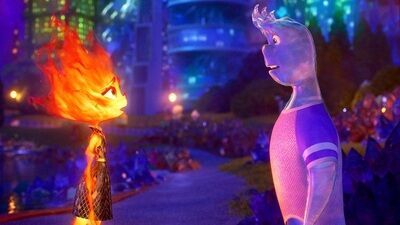“Elemental,” Disney and Pixar’s latest, feels emblematic of the studio’s struggle to recapture its original magic, making a mess of its world-building in service of a conventional story that fails the talent of the animators involved. Set in a world where natural elements—earth, fire, water, air—coexist in a New York-style metropolis, each representing different social classes, the film—directed by Peter Sohn, from a screenplay by John Hoberh, Kat Likkel, and Brenda Hsueh—aims high with that central metaphor but is set immediately off-balance by its unwieldiness as racial allegory, an issue compounded by haphazard pacing and writing so flatly predictable it suggests a Pixar film authored by an AI algorithm. At times bordering on the nonsensical, the film feels under-developed rather than universal, a colorful missed opportunity.
Presented as the closing-night selection of the 76th Cannes Film Festival, ahead of its stateside release in mid-June, “Elemental” envisions a densely populated urban sprawl similar to that of Disney’s anthrozoomorphic “Zootopia,” in which ideas of racial discrimination were uneasily reduced to “predator and prey” dynamics to allow for a story that focused more on dismantling personal prejudices than systemic racism. In Element City, a similarly ill-advised simplification is at work (though Sohn has explained that his Korean heritage and desire to make a film about assimilation fueled some of the creative decisions), and there’s even a similar eyebrow to raise with regard to the legitimate danger that these contrasting elements, like foxes to rabbits, pose to one another.
In “Elemental,” socially privileged water people flow back and forth through slickly designed high-rises and have no issue splashing down the city’s grand canals and monorails, which were designed for their gelatinous-blob bods, whereas fire folk are sequestered to Firetown, where their tight-knit community reflects East Asian, Middle Eastern, and European traditions—and accents run the gamut from Italian to Jamaican, Iranian, and West Indian, in a way that uncomfortably positions fire as representative as all immigrants and water as representative of the white upper-class. Earth and air, meanwhile, barely register; we see earth people who sprout daisies from their dirt-brown armpits, and cotton candy-esque cloud puffs playing “airball” in Cyclone Stadium, but the film is surprisingly non-committal in imagining the chemistry of inner-city elements interacting. Background sight gags abound, such as the “hot logs” that fire folk chow down on, but the actual ins and outs of Element City are explored only superficially, such as the revelation that all these elements take advantage of the same public transit. Replete with computer-generated inhabitants and generic modernist structures, its milieu feels more like concept art, to be further detailed at some point in the animation process, than a fully thought-through, lived-in environment.
Sumber: www.rogerebert.com
 Skip to content
Skip to content






